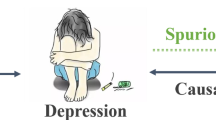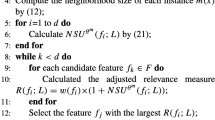Abstract
Multi-label feature selection has gained significant attention over the past decades. However, most existing algorithms are lack of interpretability and uncover the causal mechanisms. As we know, Markov blanket (MB) is a key concept in Bayesian network, which can be used to represent the local causal structure of a variable and the selected optimal features for multi-label feature selection. To select casual features for multi-label learning, in this paper, Parents and Children (PC) of each label are discovered via the Hiton method. Then, we distinguish P & C and search Spouses (SP) of each label based on neighborhood conditional mutual information. Moreover, the equivalent information phenomenon brought by multi-label datasets will cause some features to be ignored. A metric of conditional independence test is designed, which can be used to retrieve ignored features. In addition, we search common features between relevant labels and label-specific features for a single label. Finally, we propose a Multi-label Causal Feature Selection with Neighbourhood Mutual Information algorithm, called MCFS-NMI. To verify the performance of MCFS-NMI, we compare it with five well-established multi-label feature selection algorithms on six datasets. Experiment results show that the proposed algorithm achieves highly competitive performance against all comparing algorithms.









Similar content being viewed by others
References
Samah JF, Aditya T (2018) Exploiting MEDLINE for gene molecular function prediction via NMF based multi-label classification. J Biomed Inform 86:160–166
Liu Y, Wen K, Gao Q et al (2018) SVM based multi-label learning with missing labels for image annotation. Pattern Recognit 78:307–317
Liu J, Wang C, Wu Y et al (2017) Deep learning for extreme multi-label text classification. In: Proceedings of the 40th international ACM conference on research and development in information retrieval, pp 115–124
Wu Q, Tan M, Song H et al (2016) Ml-forest: a multi-label tree ensemble method for multi-label classification. IEEE Trans Knowl Data Eng 28(10):1–1
Lin Y, Hu Q, Liu J et al (2015) Multi-label feature selection based on max-dependency and min-redundancy. Neurocomputing 168(30):92–103
Pereira RB, Plastino A, Zadrozny B et al (2018) Categorizing feature selection methods for multi-label classification. Artif Intell Rev 49(1):57–78
Huang R, Kang L (2021) Local positive and negative label correlation analysis with label awareness for multi-label classification. Int J Mach Learn. https://doi.org/10.1007/s13042-021-01352-2
Karagoz G, Yazici A, Dokeroglu T et al (2021) A new framework of multi-objective evolutionary algorithms for feature selection and multi-label classification of video data. Int J Mach Learn. https://doi.org/10.1007/s13042-020-01156-w
Godbole S, Sarawagi S (2004) Discriminative methods for multi-labeled classification. In: Conference on advances in knowledge discovery and data. Berlin, Heidelberg, pp 22–30
Zhang Y, Zhou Z (2010) Multilabel dimensionality reduction via dependence maximization. ACM Trans Knowl Discov Data 4:1–21
Jian L, Li J, Shu, K et al (2016) Multi-label informed feature selection. In: Proceedings of 26th international joint conference on artificial intelligence. New York, New York, pp 1627–1633
Aliferis CF, Statnikov AR, Tsamardinos I et al (2010) Local causal and Markov blanket induction for causal discovery and feature selection for classification part I: algorithms and empirical evaluation. J Mach Learn Res 11(1):171–234
Yu K, Liu L, Li J et al (2020) Multi-source causal feature selection. IEEE Trans Pattern Anal Mach Intell 42(9):2240–2256
Aliferis CF, Statnikov A, Tsamardinos I et al (2010) Local causal and Markov blanket induction for causal discovery and feature selection for classification part II: analysis and extensions. J Mach Learn Res 11(10):235–284
Tsamardinos I, Aliferis CF (2003) Towards principled feature selection: relevancy, filters and wrappers. In: Proceedings of the 9th international workshop on artificial intelligence and statistics
Andrs RM, Serafn M (2012) A Bayesian stochastic search method for discovering Markov boundaries. Knowl Based Syst 35:211–223
Statnikov A, Lytkin NI, Lemeire J et al (2013) Algorithms for discovery of multiple Markov boundaries. J Mach Learn Res 14:499–566
Pellet JP, Elisseeff A (2008) Using Markov blankets for causal structure learning. J Mach Learn Res 9(9):1295–1342
Wu X, Jiang B, Yu K et al (2020) Multi-label causal feature selection. In: Proceedings of the AAAI conference on artificial intelligence, vol 34, no 4, pp 6430–6437
Zhang M, Wu L (2015) Lift: multi-label learning with label-specific features. IEEE Trans Pattern Anal Mach Intell 37(1):107–120
Wu X, Jiang B, Zhong Y et al (2020) Multi-label causal variable discovery: learning common causal variables and label-specific causal variables. https://arxiv.org/abs/2011.04176. Accessed 9 Nov 2020
Wang YS, Drton M (2020) High-dimensional causal discovery under non-Gaussianity. Biometrika 107:41–59
Cai R, Zhang Z, Hao Z (2013) Causal gene identification using combinatorial V-structure search. Neural Netw 43:63–71
Wu X, Jiang B, Yu K (2020) Accurate Markov boundary discovery for causal feature selection. IEEE Trans Cybern 50(12):4983–4996
Spirtes P, Glymour C, Scheines R (1993) Causation, prediction, and search. Springer, New York
Pearl J (1988) Probabilistic reasoning in intelligent systems: networks of plausible inference. Morgan Kaufmann Publishers Inc, San Francisco
Neapolitan RE, Xia J (2007) Learning Bayesian networks—ScienceDirect. Probab Methods Financ Mark Inform 31(3):111–175
Pearl J (2014) Probabilistic reasoning in intelligent systems: networks of plausible inference. Elsevier, Amsterdam
Gao T, Ji Q (2017) Efficient Markov blanket discovery and its application. IEEE Trans Cybern 47(5):1169–1179
Hu Q, Zhang L, Zhang D et al (2011) Measuring relevance between discrete and continuous features based on neighborhood mutual information. Expert Syst Appl Int J 38(9):10737–10750
Zhang M, Zhou Z (2014) A review on multi-label learning algorithms. IEEE Trans Knowl Data Eng 26(8):1819–1837
Aliferis CF, Tsamardinos I, Statnikov A (2003) HITON: a novel Markov blanket algorithm for optimal variable selection. In: AMIA annual symposium proceedings 2003
Ma J, Chow T (2020) Topic-based instance and feature selection in multilabel classification. IEEE Trans Neural Netw Learn Syst 33(1):315–329
Huang R, Jiang W, Sun G (2018) Manifold-based constraint Laplacian score for multi-label feature selection. Pattern Recognit Lett 112:346–352
Lee J, Kim D (2013) Feature selection for multi-label classification using multivariate mutual information. Pattern Recognit Lett 34:349–357
Zhang M, Zhou Z (2007) Ml-knn: a lazy learning approach to multi-label learning. Pattern Recognit 40:2038–2048
Schapire R, Singer Y (2000) BoosTexter: a boosting-based system for text categorization. Mach Learn 39:125–168
Lin Y, Li Y, Wang C et al (2018) Attribute reduction for multi-label learning with fuzzy rough set. Knowl Based Syst 152(15):51–61
Tellegen A, Watson D, Clark LA (1999) On the dimensional and hierarchical structure of affect. Psychol Sci 10(4):297–303
Acknowledgements
This work is supported by Grants from the National Natural Science Foundation of China (No.62076116), the Natural Science Foundation of Fujian Province (Nos. 2021J02049, 2020J01811, and 2020J01792).
Author information
Authors and Affiliations
Corresponding author
Additional information
Publisher's Note
Springer Nature remains neutral with regard to jurisdictional claims in published maps and institutional affiliations.
Rights and permissions
Springer Nature or its licensor holds exclusive rights to this article under a publishing agreement with the author(s) or other rightsholder(s); author self-archiving of the accepted manuscript version of this article is solely governed by the terms of such publishing agreement and applicable law.
About this article
Cite this article
Wang, J., Lin, Y., Li, L. et al. Multi-label causal feature selection based on neighbourhood mutual information. Int. J. Mach. Learn. & Cyber. 13, 3509–3522 (2022). https://doi.org/10.1007/s13042-022-01609-4
Received:
Accepted:
Published:
Issue Date:
DOI: https://doi.org/10.1007/s13042-022-01609-4




